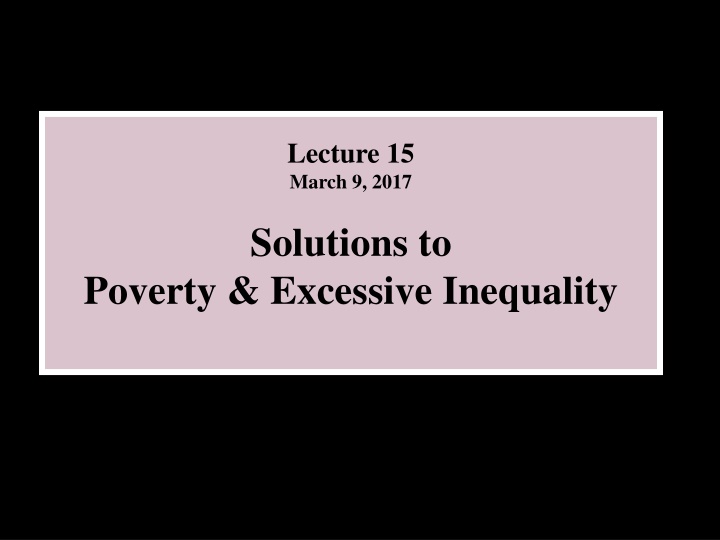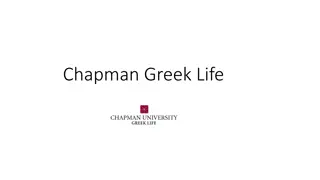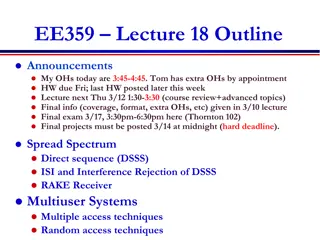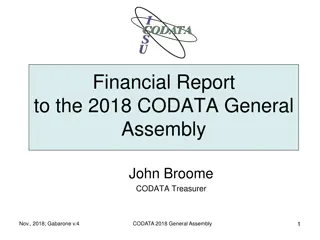
Solutions to Poverty & Excessive Inequality
Explore the concept of government welfare, its forms, and examples of welfare for privileged groups, shedding light on the disparities in subsidies across different social categories like students, homeowners, and corporations.
Download Presentation

Please find below an Image/Link to download the presentation.
The content on the website is provided AS IS for your information and personal use only. It may not be sold, licensed, or shared on other websites without obtaining consent from the author. If you encounter any issues during the download, it is possible that the publisher has removed the file from their server.
You are allowed to download the files provided on this website for personal or commercial use, subject to the condition that they are used lawfully. All files are the property of their respective owners.
The content on the website is provided AS IS for your information and personal use only. It may not be sold, licensed, or shared on other websites without obtaining consent from the author.
E N D
Presentation Transcript
Lecture 15 March 9, 2017 Solutions to Poverty & Excessive Inequality
What is Government Welfare? Government Welfare is any government subsidy to a particular group of people which provides them with an economic benefit that they would not have had if things were just left to the market.
What is Government Welfare? Government Welfare is any government subsidy to a particular group of people which provides them with an economic benefit that they would not have had if things were just left to the market.
Two main forms of welfare spending 1. Direct government spending: food stamps, public housing, cash transfers 2. Tax Subsidies: mortgage deductions, earned income tax credit for working poor, tax deductions for business expenses
Examples of welfare for already privileged social groups
Examples of welfare for already privileged social groups Students: tuition subsidies
Examples of welfare for already privileged social groups Students: tuition subsidies Homeowners: mortgage deduction 48% of mortgage subsidies go to top 20% of income distribution. Mortgage subsidy is more than 4 times the spending on public housing for the poor.
Examples of welfare for already privileged social groups Students: tuition subsidies Homeowners: mortgage deduction 48% of mortgage subsidies go to top 20% of income distribution. Mortgage subsidy is more than 4 times the spending on public housing for the poor. Farm subsidies: Around $30 billion a year: 80% goes to corporate agriculture, NOT family farmers. Corporations: Corporate welfare = $75 Billion/year
Examples of welfare for already privileged social groups Students: tuition subsidies Homeowners: mortgage deduction 48% of mortgage subsidies go to top 20% of income distribution. Mortgage subsidy is more than 4 times the spending on public housing for the poor. Farm subsidies: Around $30 billion a year: 80% goes to corporate agriculture, NOT family farmers. Corporations: Corporate welfare = $75 Billion/year
Examples of Corporate Welfare (from the conservative Cato Institute s Handbook for Congress ) The Energy Department's Energy Supply Research and Development Program ($2.7 billion a year) aims to develop new energy technologies and improve on existing technologies. Commerce Department's Advanced Technology Program ($200 million a year) gives research grants to consortiums of some of the nation's largest high-tech companies. The Export-Import Bank ($700 million a year) provides subsidized financing to foreign purchasers of U.S. goods. Overseas Private Investment Corporation ($70 million a year) provides direct loans, guaranteed loans, and political risk insurance to U.S. firms that invest in developing countries.
Solutions to Poverty: three kinds of structural proposals Partially decouple standards of living from market earnings: the social wage Universal health care, good public day care, public libraries and swimming pools, free universities, etc. 1. 2. Partially decouple paid employment from capitalist markets: public sector jobs. 3. Partially decouple income from earnings: Asset development accounts Basic Income Grants
Solutions to Poverty: three kinds of structural proposals Partially decouple standards of living from market earnings: the social wage Universal health care, good subsidized day care, public libraries and swimming pools, free universities, etc. 1. 2. Partially decouple paid employment from capitalist markets: public sector jobs. 3. Partially decouple income from earnings: Asset development accounts Basic Income Grants
Solutions to Poverty: three kinds of structural proposals Partially decouple standards of living from market earnings: the social wage Universal health care, good subsidized day care, public libraries and swimming pools, free universities, etc. 1. 2. Partially decouple paid employment from capitalist markets: public sector jobs. 3. Partially decouple income from earnings: Asset development accounts Basic Income Grants
Solutions to Poverty: three kinds of structural proposals Partially decouple standards of living from market earnings: the social wage Universal health care, good subsidized day care, public libraries and swimming pools, free universities, etc. 1. 2. Partially decouple paid employment from capitalist markets: public sector jobs. 3. Partially decouple income from earnings: Asset development accounts Unconditional Basic Income
UNCONDITIONAL BASIC INCOME (UBI) Central principles: 1. Basic income: provides for a decent, no frills standard of living above the poverty line 2. Universal: given to all citizens 3. Unconditional: no restrictions, no work requirements
UNCONDITIONAL BASIC INCOME (UBI) Central principles: 1. Basic income: provides for a decent, no frills standard of living above the poverty line 2. Universal: given to all citizens 3. Unconditional: no restrictions, no work requirements
UNCONDITIONAL BASIC INCOME (UBI) Central principles: 1. Basic income: provides for a decent, no frills standard of living above the poverty line 2. Universal: given to all citizens 3. Unconditional: no restrictions, no work requirements
UNCONDITIONAL BASIC INCOME (UBI) Central principles: 1. Basic income: provides for a decent, no frills standard of living above the poverty line 2. Universal: given to all citizens 3. Unconditional: no restrictions; no work requirements; no moral test.
Means-tested vs Universal Programs Means-tested = a person only gets a benefit if they fall below some level of income. Example: food stamps. Universal programs = everyone gets the benefit regardless of income. Examples: public education, Medicare.
Means-tested vs Universal Programs Means-tested = a person only gets a benefit if they fall below some level of income. Example: food stamps. Universal programs = everyone gets the benefit regardless of income. Examples: public education, Medicare.
Problems with means-tested programs 1. Stigma: recipients are labeled negatively 2. Weak basis of public support: universal programs build bridges across groups; means-tested programs create cleavages between groups 3. Universal programs become rights; means-tested programs viewed as charity 4. Result: universal programs usually do more to help the poor than means tested programs.
Problems with means-tested programs 1. Stigma: recipients are labeled negatively 2. Weak basis of public support: universal programs build bridges across groups; means-tested programs create cleavages between groups 3. Universal programs become rights; means-tested programs viewed as charity 4. Result: universal programs usually do more to help the poor than means tested programs.
Problems with means-tested programs 1. Stigma: recipients are labeled negatively 2. Weak basis of public support: universal programs build bridges across groups; means-tested programs create cleavages between groups 3. Universal programs become rights; means-tested programs viewed as charity 4. Result: universal programs usually do more to help the poor than means tested programs.
Problems with means-tested programs 1. Stigma: recipients are labeled negatively 2. Weak basis of public support: universal programs build bridges across groups; means-tested programs create cleavages between groups 3. Universal programs become rights; means-tested programs are viewed as charity 4. Result: universal programs usually do more to help the poor than means tested programs.
Problems with means-tested programs 1. Stigma: recipients are labeled negatively 2. Weak basis of public support: universal programs build bridges across groups; means-tested programs create cleavages between groups 3. Universal programs become rights; means-tested programs are viewed as charity 4. Result: universal programs usually do more to help the poor than means-tested programs.
Potential Consequences of BIG 1. Eliminates extreme poverty without stigma 2. Facilitates nonmarket activity: in the arts, caregiving, community activism 3. Gives everyone a measure of real freedom (positive freedom) 4. Strengthens negative freedom: the freedom to say no 5. Puts pressure on employers to innovate to eliminate unpleasant, boring work because it is costly
Potential Consequences of BIG 1. Eliminates extreme poverty without stigma 2. Facilitates nonmarket activity: in the arts, caregiving, community activism 3. Gives everyone a measure of real freedom (positive freedom) 4. Strengthens negative freedom: the freedom to say no 5. Puts pressure on employers to innovate to eliminate unpleasant, boring work because it is costly
Potential Consequences of BIG 1. Eliminates extreme poverty without stigma 2. Facilitates nonmarket activity: in the arts, caregiving, community activism 3. Gives everyone a measure of real freedom (positive freedom) 4. Strengthens negative freedom: the freedom to say no 5. Puts pressure on employers to innovate to eliminate unpleasant, boring work because it is costly
Potential Consequences of BIG 1. Eliminates extreme poverty without stigma 2. Facilitates nonmarket activity: in the arts, caregiving, community activism 3. Gives everyone a measure of real freedom (positive freedom) 4. Strengthens negative freedom: the freedom to say no 5. Puts pressure on employers to innovate to eliminate unpleasant, boring work because it is costly
Potential Consequences of BIG 1. Eliminates extreme poverty without stigma 2. Facilitates nonmarket activity: in the arts, caregiving, community activism 3. Gives everyone a measure of real freedom (positive freedom) 4. Strengthens negative freedom: the freedom to say no 5. Puts pressure on employers to innovate to eliminate unpleasant, boring work because it is costly
Will it Work? Two pragmatic arguments against BIG: 1. Too many people will stop working for pay and thus not enough income will be generated to sustain the system. 2. Taxes to pay for BIG will be so high that there will be huge disincentives to invest and to work.
Will it Work? Two pragmatic arguments against BIG: 1. Too many people will stop working for pay and thus not enough income will be generated to sustain the system. 2. Taxes to pay for BIG will be so high that there will be huge disincentives to invest and to work.
Will it Work? Two pragmatic arguments against BIG: 1. Too many people will stop working for pay and thus not enough income will be generated to sustain the system. 2. Taxes to pay for BIG will be so high that there will be huge disincentives to invest and to work.






